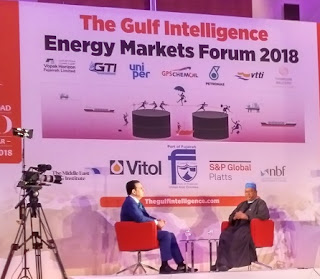As the Oilholic headed for a splash and dash visit to the familiar surroundings of Vienna on another early morning British Airways flight to the Austrian capital on Friday (November 23), one couldn't but help notice that yet another oil futures selloff was underway in Asia, with regional closing trends indicative of 2% declines.
By the time this blogger landed at Vienna International Airport at half past noon, the decline had become more pronounced in European trading hours. And a few hours later in the US, the intraday rout was complete with both WTI and Brent front-month contracts registering declines of tad over 7%.
What is worth noting here is that the latest drop is the third such decline - not just in the quarter, or on the month, but in the short space of a mere 10 trading sessions. Overall, crude prices have slumped by 30% over the last 7 weeks; quite something given the amount of bullish nonsense that was on the airwaves prior to the slide.
If this isn't a slump, what is? Especially, as Brent also slid below $60 per barrel. Not so long ago, the global proxy benchmark was approaching $85, leading to typical exaggerated market forecasts in some quarters that the benchmark would hit $100 over Q1 2019.
Those who never believed such predictions, including this blogger, and expressed a net-short position ought to feel vindicated. The froth has gone out of the market, and sentiment remains largely bearish. However, there is such a thing as an 'over-correction'. The Oilholic thinks the slide has been too steep, too fast because the macroeconomic dynamic on the supply side has not undergone a similar sentimental slump.
The Trump-China face-off, global growth rate (which is steady but not quite firing up), possibility of European upheavals (Brexit, Italy, Greece, Spain, etc), and an unimpressive oil demand growth range of 1.1 to 1.4 million barrels per day (bpd), were all priced in when the WTI was lurking in the $60s and Brent in $70s.
That for the Oilholic was the optimal range/level for both contracts, before the so-called false prophets exaggerated the impact of Iranian sanctions slapped unilaterally by the US on Tehran. Hedge Funds and money managers then piled in, as they tend to with jumped up net-long calls, in the hope of extending the rally and Brent hit thoroughly unmerited $80+ intraday levels.
Therefore, when the initial correction hit, dragging Brent first down to $70, and subsequently below, it was merited. However, the Oilholic believes we are in an over-correction patch now. The market is in a real danger of swapping one extreme for another, and as usual the false prophets are it again, with some predicting a slump to $40 and below. The volatility of the last few weeks has delivered a classic lesson on why not to trust them.

Moving on from 'crude' rants, the Oilholic was delighted to speak at the World Energy Council's (WEC) Vienna Energy Summit, which is what the early morning departure from Heathrow and earlier than usual scrutiny of oil prices in East Asia - should you follow one on Twitter - was all about.
The summit addressed a number of crucial subjects, and gave due weight to the macroeconomic and sociopolitical climate beyond current and future permutations in the energy markets.
Fellow panellists and yours truly deliberated, Saudi Arabia's transformation (at least on paper) to renewable energy, impact of regulations on the oil price and world order, petro-yuan hypothesis, those inimitable Donald Trump tweets and diplomacy by social media, Iran sanctions and much more.
It was a great industry dialogue, and a pleasure finally connecting with Dr Robert Kobau, Secretary General of WEC Austria (above right). With so much ground to cover, the session just flew by and animated, good spirited discussions spilled over to the after event reception, as how industry dialogues should be. All the remains, is to say it's time for the big flying bus home! Keeping reading, keep it ‘crude’!
To follow The Oilholic on Twitter click here.
To follow The Oilholic on Google+ click here.
To follow The Oilholic on Forbes click here.
To email: gaurav.sharma@oilholicssynonymous.com
© Gaurav Sharma 2018. Photo: Gaurav Sharma with Dr Robert Kobau, © Gaurav Sharma 2018.






















